Who doesn’t love owls? Owls are some of the most recognizable, adorable-looking creatures (especially the tiny ones!). They have a distinct shape, often prominent ear tufts, large eyes, and impressive talons at the end of their toes.
Their hunting techniques are highly efficient, their vision is exceptional, and their unique adaptations suit them for their nighttime forays.
Owls comprise around 200 species worldwide, from the smallest species, the Elf Owl, to the largest species – like the enormous-looking Great Grey Owl.
Each owl species is unique, with various colors, plumage patterns, and body shapes. The species are divided into two families, Tytonidae and Strigidae.
They’re all ferocious predators who don’t blink an eye when the opportunity to catch a rodent or other small prey item is available. The prey items owls favor differ between the species and geographic areas.
Still, they generally eat small mammals (predominantly small rodents), birds, amphibians, reptiles, insects (particularly moths), and sometimes even fish. Owls catch and kill their prey using their long legs and talons.
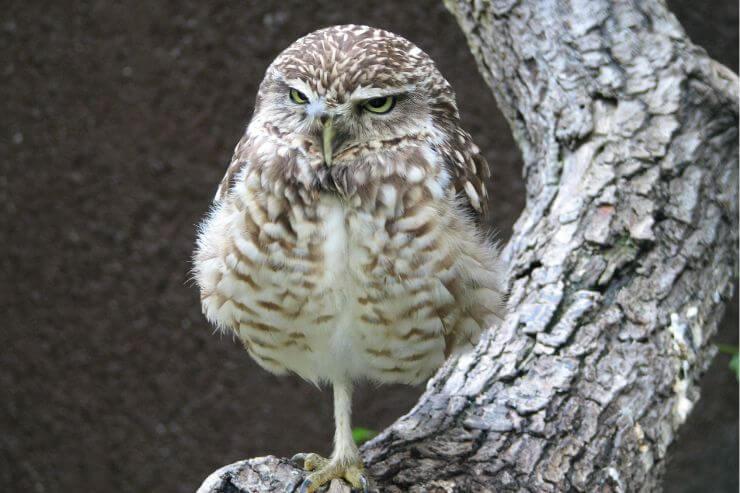
Based on how you usually see owls, it may be difficult to believe, but their legs are often very long and pale yellow or grey. If you’ve seen photos of owl legs without the dense feathery covering, you’ll know just how long their legs can be.
If you’d like to find out more about owl legs, read on to learn more!
Owl legs have a fascinating design, which is similar to most birds. They have a very short thigh bone (femur) and long shin bones.
When you see owl legs, the main joint you’re likely to see is often mistaken as being the knee, but it is, in fact, the ankle, as birds have very long feet.
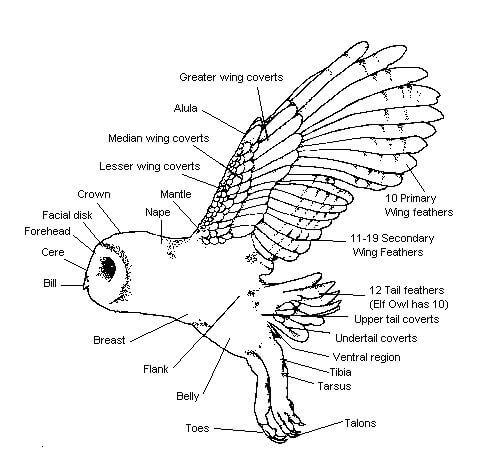
Therefore, it may not seem like owls have knees because they are found near the top of their legs. They are very close to their bodies and covered in feathers.
Owls have feet containing four toes. On the end of each toe is a claw (also known as a talon). The toes are arranged uniquely – different from most other birds.
The two toes on the edges (first and fourth toes) point backward, while the two middle toes (second and third toes) point forwards. That arrangement makes their feet zygodactyl, and it enables owls to pick up prey and perch effectively.
Owl claws, like those on diurnal raptors, are incredibly sharp. The zygodactyl arrangement and the sharpness enable owls to grip prey from opposite sides, preventing the prey from escaping and, in the end, making the kill. The zygodactyl arrangement also allows the owl to hold steadily onto branches and other perches with their toes.
The ankle joint is crucial as it allows the owl to rotate its toes and catch prey from all angles. The high knee placement is also vital, enabling owls to be more flexible and have more leg movement, which aids hunting and, therefore, survival.
On owl legs, a joint connects the thigh to the body and is located further forward on an owl’s body than on many other types of birds. This adaptation allows them to rotate their legs further forward and perch without losing balance and falling off.
You don’t typically see owl legs because feathers cover them. The feathers function in providing insulation and keeping the owls warm at night.

There are some owl species with feathered feet. That adaption allows them to tiptoe on the ground, sneaking up on prey items and pouncing without needing to fly.
Owls’ legs are well protected from any of the prey items that try to bite them by their hard, scaled skin.
Owls have two legs, which are located underneath their bodies.
Owl legs are thin, feathered, and lightweight. Those features allow them to move efficiently and quietly, whether in flight or while walking on the ground.
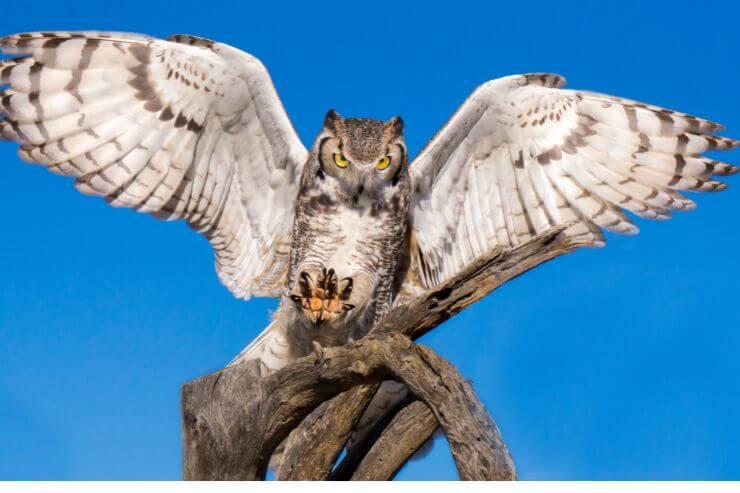
As you know by now, owls have very long legs. So long, in fact, that they can be almost half as long as their bodies. The deviation is quite significant, and the length of owl legs varies by species. Small owls have much shorter legs than large owls.
The ratio of owl leg length to body size varies dramatically between species, with some species having short legs compared to their bodies and others having longer legs.
Other than the fact that smaller owls typically have shorter legs, some of the main reasons behind an owl’s leg length are their environment and hunting methods.
Owls live in different environments, from open habitats like fields and tundra to forests. The birds living in each environment require different-sized lengths for many reasons. Owls that hunt in fields, grasslands, and other open areas have longer legs because they need to capture prey in tall grass or walk on the ground.
Long legs would be a disadvantage in forests as they would get in the way of maneuverability. Therefore, birds that hunt in forests have shorter legs. The short legs mean they can fly and move easily around trees and other vegetation.
The shortest owl legs are as short as 4 inches (10 centimeters), while the longest owl legs are up to 15 inches (38 centimeters) in length.
The record of the longest owl legs belongs to the Eurasian Eagle-owl, whose legs measure in at a whopping 15 inches (38 centimeters) long.
As you know from seeing photos on the internet, owl legs are long and thin. They’re usually disproportionately thin compared to the rest of the body and can look delicate. However, owls have powerful, thick legs with essential functions in their day-to-day (or night-to-night, shall we say?) lives.
Owls need to have significantly strong legs as they are mainly used for hunting animals at night. Their legs must be strong enough to capture the prey, pin it down to the ground, and prevent it from escaping.
Apart from hunting, owl legs are long and thin because they are required for flight, warmth, and maneuvering in the environment.
Owls are formidable hunters equipped with adaptations that make them perfect for catching creatures in the depths of the night. They usually hunt from a perch, observing their surroundings for anything that moves.
Once an animal has been seen, they swoop down. They fly efficiently and silently through the air. Once within striking distance, they pounce on the unknowing creature by grabbing it with their talons. Their sharp talons grip the animal tightly and kill it by causing stab wounds or constriction. Owls also have strong, sharp beaks that they sometimes use to crush the prey item if the talons haven’t done the job.
The ferocity of owl talons doesn’t end there. They have potent feet and can grip their prey while exerting a force of approximately 500 pounds per square inch.
It would be difficult for any creature to survive the sharp talons and the substantial force delivered. They can pick up prey that weighs far more than they do due to the strength of their legs.
One of the most critical evolutionary advantages of using feet and talons to capture and kill prey is protecting the predator’s head from harm. Owls rely heavily on their eyes to find prey, so using their talons to kill them mitigates the chances of injuring those critical organs.
As discussed previously, Owls have short thighs and long shins. There is a reason why owls have long, thin legs with short thighs, and that is flight.
To fly successfully, birds must keep their weight in the middle of their bodies to ensure a balanced distribution. That prevents them from falling over and keeps them steady while flying.
The strength in owl legs comes mainly from the thighs, which contain large muscles. Large muscles carry a lot of weight, so owls have short thighs that are very close to their bodies. It keeps the weight distribution near the center and evenly distributed.
If the thighs were more extended, there would be a wider weight distribution, and the legs’ weight would prevent them from flying efficiently. Their legs are long and thin from the knees to their toes, making them light enough to have minimal impact on weight and flight.
Many owls live in frigid, cold environments. Their leg structure allows them to survive in cold conditions. As with humans, their external limbs are usually colder than body parts considered more important, like their chests.
Owl legs are made from bones and connected by tendons, so they can become freezing without affecting the owls detrimentally. Therefore, they can let their feet and legs get far colder than the rest of their bodies which hold organs and muscles needed for survival, without losing bodily functions.
Some owls, like the Snowy Owl that lives in frigid conditions, also have dense feathers on their bellies to help hold onto body warmth in addition to the leg feathers. The Great Grey Owl has so much layering on the body that you may only see its claws and eyes exposed. It makes them appear to be larger than they are.
When it comes to flying, owls do it exceptionally silently. They’ll fly right past you without you knowing they’re there if they don’t call.
They have adaptions on their wings that allow them to cause no sound, but their long legs also aid in muffling the sound. The long legs absorb the shock of landing in trees and on the ground, causing noise reduction and the sound of landing to dissipate.
Owls are carnivorous creatures that catch and eat prey by hunting them at night. Owls typically hunt in open areas where they can easily find prey and where perches like trees are found. They usually perch on a tree and look for prey items on the ground.
Once they see an animal they’d like to eat, they swoop in silence, extend their legs, open their toes and talons, and grab their prey. The sharp, strong talons kill the prey. The owl usually carries away the prey to a safe eating spot.
Owl legs have a strange look caused by their unique design, with really long shin bones and short thighs.
Yes, you read that correctly. Owls hunt fish. You don’t see it frequently; only a few species do it. Some species, like the Pel’s Fishing Owl, are specialized to catch fish, as their name suggests.
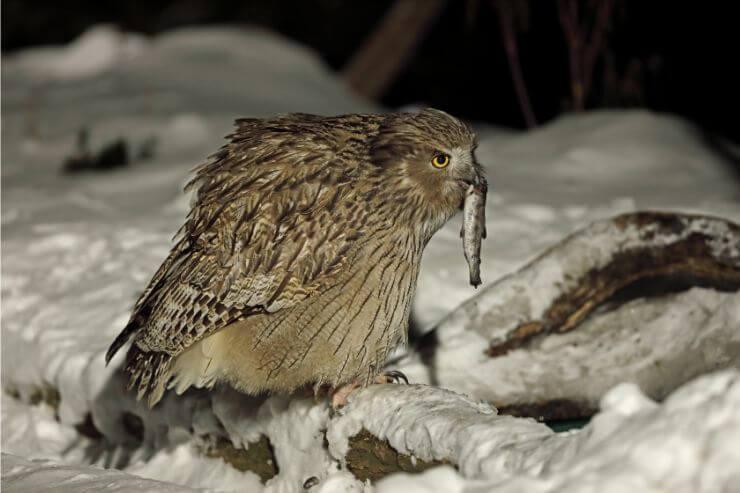
These owls regularly sit in large trees along rivers and fly down to catch the fish when they see one near the surface. They skim the water’s surface with their talons and grasp the fish when they hunt.
Another remarkable adaptation that owls have is their ability to perch on a branch, wrap their toes around it, and lock themselves in position. The reasoning is that, unlike human hands that relax when open, owl feet are relaxed when closed. Therefore, grasping onto a perch to sleep allows them to relax their muscles.
Once an animal has been caught and the owl is in a safe place to eat, the owl uses its feet to hold the prey while it tears off pieces of flesh with its beak. This is usually done when the owl needs to feed its chicks.
Owls that swallow their prey whole will use one of their feet to lift the prey item and move it toward its beak.
Unlike many other birds, owls have feathered legs that appear fluffy. Owls have feathered legs to keep themselves warm and help with thermoregulation.
In the far northern, freezing areas, owls also have feathered feet, which help insulate their bodies even more. That is because the owls usually have to hunt in snow or on frozen ground when the temperatures are well below zero.
For most owl species, the feathered legs allow them to stay warm at night while they hunt.
Owls can and certainly do walk. It’s just not something they frequently do, as flying from one place to another is more energy efficient. Their legs and feet also aren’t designed for walking. They are adapted to perching and flying rather than walking.
Owls can climb trees with their talons, which can look like they’re walking up the side of a tree. They are more suited to this behavior as they use their sharp talons to grasp onto the tree, and their strong legs help them move up.
An owl walking could be a bad sign because it can indicate that the owl is sick or injured, so they are unable to fly.
Have you ever seen an owl walking? If you have, you’d be able to imagine how funny they’d look if they were to run. Luckily for those of you that find owls entertaining, owls can and do run and can be very amusing.
However, owls rarely run. They are far more suited to flying, hopping, and perching, so they use those strategies to hunt and capture prey rather than running.
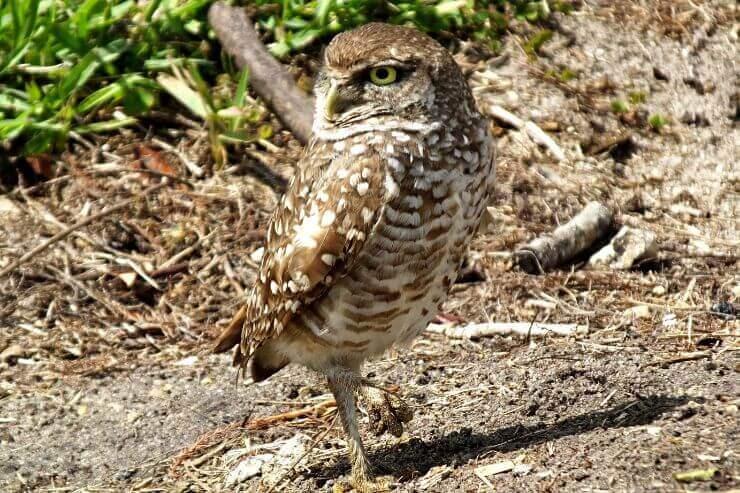
The owl you’re most likely to see running is the Burrowing Owl. Burrowing Owls can pick up quite a speed and run pretty fast for a little owl.
Burrowing Owls are often active during the day as they enjoy eating insects. So if you spend time at a Burrowing Owl burrow, you may see them chasing and catching insects and other prey items that they find on the ground.
In conclusion, owl legs may not constantly be visible (other than the feet), but they’re there, and they’re stronger than they look. Owl legs are extremely powerful, enabling them to take down a range of different creatures.
Their legs are often very long compared to their bodies. There are a number of reasons for this, including hunting, flight, warmth, and maneuverability. Owl legs are also perceived to be longer than they actually are because of their skinniness.
They are thin as it provides a balanced weight distribution, allowing them to fly efficiently. This feature is not limited to owls; however, it’s the reason why all birds have thin legs. It prevents the weight from being on the edges of their bodies.
You may not be able to see owl legs properly because they have dense layers of feathers (leggings) that keep them covered for warmth and catching prey. The leggings are particularly beneficial to owls that live in freezing, harsh environments that need extra warmth.





